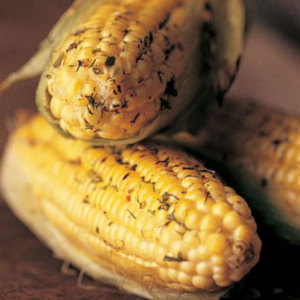Every year, we grow four to five varieties of sweet corn for our CSA members — along with extra quantities that sell out extremely quickly at our farm stands at Atwater and Jean-Talon markets in Montreal. We don’t grow a lot, because corn is something of a loss leader, i.e. it is uneconomical to grow corn on a diversified organic farm such as ours. At one cob per stalk, it takes up a lot of space in the field; biological pest control is costly; setting up electric fencing to ward off roaming raccoons is time consuming; the list goes on. But we deem our farm offering wouldn’t be complete without corn. A Québec summer just wouldn’t be the same without it.
Indigenous populations in present-day Mexico first domesticated corn around 10,000 years ago. Its long history in that country explains why it continues to be such a staple food there today. Nearly every typical Mexican dish revolves around corn in some way. Corn has since spread throughout the world and has become a major source of food in Africa, Europe, and the US. People boil and eat it whole, dry and pulverize it to make flour, and cook it in sweetened milk for dessert. It can be processed for other uses that include as ingredients in sweeteners (corn syrup), alcohol (whiskey), and cooking oil. Globally, humans get a whopping 19.5% of their calorie intake from corn. At least it’s gluten-free…!
Back to our corn, though — and we admit we’re biased: we believe you haven’t really tasted corn until you’ve tasted ours. When we put it in your CSA basket or bring it to the market, it has been harvested the very same day; on market days, starting as early as 5 am. On the farm, we like to eat it raw, preferably as soon as it is harvested, certainly the same day it is picked. Sweet corn is almost like a fruit when it is eaten that fresh. It is refreshingly delicate, its sugars have not yet begun to turn to starch. We prefer it straight up, on the cob, without butter or salt, even. Try it, we’re sure you’ll like it.
If you insist on eating it cooked, bring your water to a boil and drop your cobs into the boiling water for 2-3 minutes at most, just to heat them up. Another great way to enjoy your corn is on the grill (see first recipe below).
Three corn recipes recommended by our friend Laure — 11/08/2020
 Despite our preference for corn without butter, most corn-on-the-cob aficionados hold that lathering on butter should not only be allowed, but in fact, recommended. Williams-Sonoma’s grilled corn with seasoned butters is about as fancy as grilled corn gets. (Note: the recipe is on Williams-Sonoma’s California/US website – do not select Canadian version)
Despite our preference for corn without butter, most corn-on-the-cob aficionados hold that lathering on butter should not only be allowed, but in fact, recommended. Williams-Sonoma’s grilled corn with seasoned butters is about as fancy as grilled corn gets. (Note: the recipe is on Williams-Sonoma’s California/US website – do not select Canadian version) A great salad idea from The Vegetable Butcher, by Cara Mangini: red-leaf lettuce salad with grilled corn, peaches, avocado and walnut. Cara Mangini is the founding chef at Little Eater, a restaurant in Columbus, Ohio, USA. She is said to be on a mission to put vegetables at the center of the American plate. The Vegetable Butcher, her 2016 award-winning cookbook “explores how to Select, Prep, Slice, Dice, and Masterfully Cook Vegetables from Artichokes to Zucchini.” We really dig the tag line on the About section of the Little Eater website: ‘we believe eating vegetables is one of life’s greatest pleasures.‘ We couldn’t agree more. Besides, this recipe recommends using fresh, raw, corn. Love it.
A great salad idea from The Vegetable Butcher, by Cara Mangini: red-leaf lettuce salad with grilled corn, peaches, avocado and walnut. Cara Mangini is the founding chef at Little Eater, a restaurant in Columbus, Ohio, USA. She is said to be on a mission to put vegetables at the center of the American plate. The Vegetable Butcher, her 2016 award-winning cookbook “explores how to Select, Prep, Slice, Dice, and Masterfully Cook Vegetables from Artichokes to Zucchini.” We really dig the tag line on the About section of the Little Eater website: ‘we believe eating vegetables is one of life’s greatest pleasures.‘ We couldn’t agree more. Besides, this recipe recommends using fresh, raw, corn. Love it. And to round things out: a southern spicy corn chowder from former Food Network chef Gina Neely. (Note: the recipe is on the Food Network’s US website – do not select Canadian version)
And to round things out: a southern spicy corn chowder from former Food Network chef Gina Neely. (Note: the recipe is on the Food Network’s US website – do not select Canadian version)
